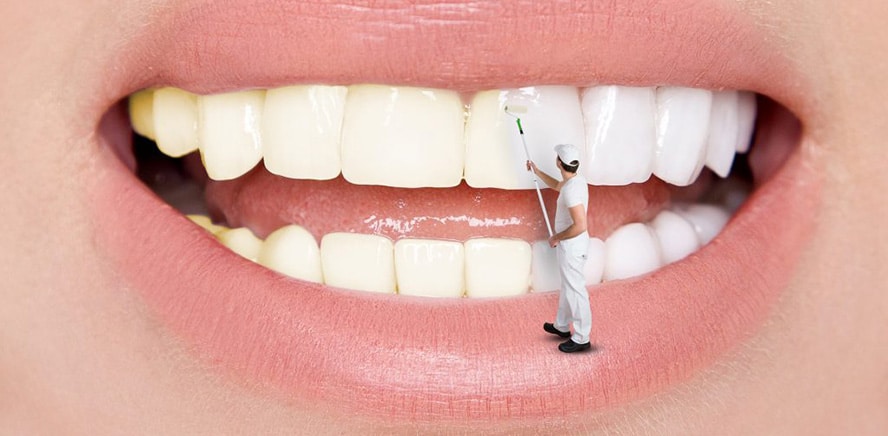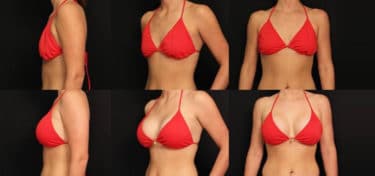Porcelain veneers is a cosmetic and restorative treatment method applied to correct defects of the teeth. It allows changing the shape, colour and size of crooked, damaged or gapped teeth. Porcelain veneers is one of methods that give an aesthetic appearance to the teeth. It provides a natural appearance similar to tooth enamel; it is durable and long-lasting. Laminates, also called leaf porcelain, is a translucent layer that fits well with the teeth. Anesthesia is not usually required during the procedure, which is performed through the attrition of the intact tooth tissue. At least 2 or 3 visits are needed for laminated crowning. However, this period may vary depending on the condition and number of the teeth. Porcelain laminate veneers can be applied to anyone over the age of 18.
Table of Contents
What is porcelain dental veneers?
Porcelain veneers is a treatment method applied to improve the appearance of damaged or defective teeth. It is performed to change the colour and shape of the teeth, to close the gaps between the teeth or to correct misaligned teeth. Porcelain crowns are nail-thick shells that are specially designed and produced in a laboratory for each patient after the measurement and reproduction of the teeth, and then attached on the teeth.
It is very similar to natural tooth enamel and it is long-lasting. Before attaching porcelain crowns, approximately 2 mm of tissue must be removed all around from the tooth. For porcelain laminates, it is sufficient to only abrade 0.3 – 0.7 mm from the front surface. (1)
Types of porcelain veneers
Crowns are thin shells placed over your existing teeth to improve their appearance. There are 2 types of tooth crowning methods: porcelain and composite. Porcelain is a kind of glass, resistant to stains and long-lasting. Composite crowns are made of a tooth-coloured resin, close to plastic in nature, and are sensitive to stains because they are porous.
Composite crowns
Direct composite crowns (Bonding applications)
Directly reproduced composite crowns from slightly roughened tooth can be attached in a single visit, lasting 30 to 60 minutes, and anesthesia is not often required. Composite crown is easy to apply and costs less than porcelain crowns, but it is not as strong as porcelain. It can be preferred especially in closing gaps between the teeth and repairing stained or slightly damaged teeth; it is effective on small areas. (2)
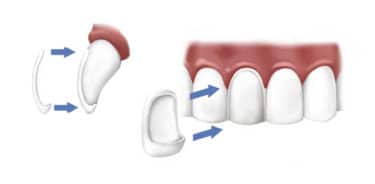
Indirect composite crowns
Application process is different in indirect composite crowns. They are produced exclusively in a dental laboratory. Temporary crown is attached on the tooth during this production period. When the crown is ready, it is placed on the tooth with a special adhesive. They are more durable against attrition and fracture than direct composite crowns, but they are more expensive. (3)
Porcelain crowns
Types of porcelain teeth may vary depending on material that supports main material or the number of teeth to be crowned, and the condition of the tooth.
Full ceramic crown
Full ceramic crown is used to remove the teeth with excessively incurred material losses or recover the damages due to the fractures. It is the most advanced crowning type made of porcelain or reinforced porcelain in its substructure. It adheres strongly to the tooth and maintains its natural appearance even in case of the gingival recession.
Before crowning, the teeth are prepared for crowning by excising around teeth to be crowned appropriately. Then the facial and lingual faces of the tooth are crowned with the produced cover. (4)
Porcelain crowns fused to metal materials
It is a method applied by placing porcelain on a metal-basis in a way to fit the tooth. This crown is disadvantageous due to graying on the edge of the gingiva as a result of the oxidation of the metal in time and the necessity to excise more of the teeth. However, it is preferred as it is durable and cheaper. It is mostly applied to the posterior teeth as it is not recommended for the anterior teeth due to aesthetical concerns.
Porcelain crowns fused to zirconium
It is a type of crowns that is very durable, natural looking, and its cold and warm sensitivity is minimal. Semimetal zirconium is aesthetic enough to be used on the anterior teeth and durable enough to be used on the posterior teeth. (5)
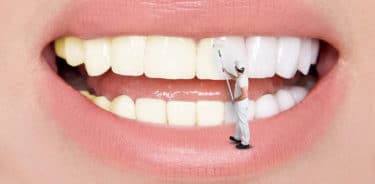
Laminate porcelain crowns (Leaf porcelain)
These are very thin porcelain shells especially applied to the anterior teeth and they are more expensive than the alternatives. During the application, the facial side of the tooth is slightly abraded (0.3 – 0.7mm) and this thinned part is crowned with a thin porcelain like nail extensions. (6)
Who can use porcelain veneers?
- Those with mild crooked teeth and dental curvatures without need for orthodontic treatment
- Those with fractured, carious or abrasive anterior teeth
- Those who have stains and discoloration on the teeth
- Those with gaps between the teeth
- Those who do not like the appearance of their teeth can have porcelain teeth crowns.
Who cannot use porcelain dental crowns?
- Those under the age of 18,
- Those with jaw disorders,
- Those who have habits such as nail biting, pencil biting, and teeth grinding,
- Those with advanced gingival recession,
- Those with significant tissue loss in their teeth due to attrition, decays or fracture,
- Those who clench their teeth while sleeping (bruxism),
- Those who do not have enough enamel tissue,
- Those with severe fluorosis, cannot have porcelain tooth crown.
How is porcelain veneers performed?
Diagnosis and treatment planning
During the first visit, patient is informed about the procedure and the teeth are examined, and x-ray is taken if necessary. A model is reproduced measuring the teeth of the patient or a three-dimensional image of the teeth is obtained using computer technology.
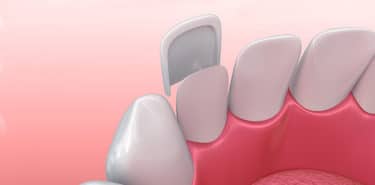
These models or images are sent to a dental laboratory for the production of crowns. It usually takes 2 to 3 weeks for the crowns to be ready, so you will need 2 to 3 visits for treatment. This period may vary depending on the number of teeth to be crowned.
Preparation porcelain veneers
In the next visit, the patient’s teeth are thoroughly cleaned and the correct colour for the crowns is determined. In order for the crowns to adhere to the teeth easily, the enamel layer is slightly abraded and measured again. A temporary crown is placed on the tooth until porcelain crowns are produced.
Tooth Bonding
When a porcelain crown is ready, it is placed temporarily to observe its compatibility for several days before permanently bonding to tooth. At the end of the period, after patient and the dentist agree on the form and colour, the crowns are fixed with a special adhesive, hardened with photocuring, excess is cleaned, and finally tooth is polished. The patient is called for a check-up a few weeks later, to check how gingiva reacts to the crowns.
How much do cost of dental crowns?
Porcelain tooth crown prices vary depending on where they are applied and how many crowns you need. Porcelain tooth crown is very costly due to special materials used, delicate laboratory processes, and expertise it requires. In UK and USA, average price per tooth can vary between 500 USD and 2000 USD.
Porcelain brace
Produced as an alternative to metal braces with the development of orthodontic technology, porcelain or transparent braces are especially preferred by adults and those with aesthetic concerns. Porcelain braces do not attract attention as they are made of glass-like material. They are also stainless dental braces.
Porcelain braces can be applied to anyone whose mouth and teeth structures are suitable. The treatment of porcelain braces takes longer than metal braces; however, it is completed in approximately 1 to 2.5 years.
How to remove porcelain crown?
Porcelain crowning is an irreversible dental procedure, as the teeth are abraded. However, it has a certain lifetime; crowns may need to be removed due to the changes in the mouth and gingiva over time. It is possible to remove the crown from the tooth forcing the crown edge with the crown removers produced for the process.
However, if it is not applied by an experienced dentist, the crowned tooth may be fractured. After grooving crowns with a long and laborious process, the crown is cut and removed from the tooth.
Do porcelain laminate veneers is fall out?
Porcelain laminate teeth are bonded using very strong adhesives. The risk of falling out is almost non-existent, but you should never try to put excessive pressure on your teeth. Avoid habits such as biting very hard foods and nail biting.
How long can porcelain laminate crowns be used?
Porcelain laminate teeth can be used for a very long time, i.e. 10 to 20 years, with a good oral care.
What are the advantages of porcelain laminate veneers?
- It is long-lasting thanks to the strong material
- It effectively crowns cracks, stains and malformations
- Porcelain is stainless material, does not get discoloured and is resistant to breakage
- As the abrasion on the tooth surface is minimal or no abrasion is made, the natural structure of the teeth is not deteriorated. There is no need to reduce the size of the tooth all around, as in the crown application
- Its tooth-like thin and transparent structure provides a natural appearance
- It is resistant to stains as it has a smooth surface. It also reduces tartar formation
- It is not an allergic material
- It does not contain metal, thus, it does not cause graying in the gingiva over time
- Light transmittance and reflecting are very similar to natural tooth
- It is highly abrasion-resistant
- Tooth adherence after bonding is very good
- Anesthesia is not common during application.
What are the disadvantages of porcelain crowns?
The planning and production&application phase of porcelain laminate teeth requires a precise working process, so it costs more than other applications.
- More than one visit is required for the preparation and placement of crowns
- Its application requires expertise
- Although its adherence to the teeth is very strong, there is a possibility of falling out or breakage by a severe impact and it is difficult to repair when the porcelain laminates are broken
- It is an irreversible procedure as the teeth are permanently abraded
- It is a stainless material, but just like natural teeth, yellowing can occur in porcelain laminate teeth.
What to avoid after porcelain crowning?
- After the treatment, a patient should try not to consume excessive hot or cold foods and drinks for at least a week, and avoid hard and sticky foods.
- If the porcelain tooth is broken, cracked or fall out, you should consult you doctor immediately. In such cases, the broken or cracked part is either replaced or a new crown is placed.
- With a good oral hygiene, porcelain crowns can be used for a long time; teeth should be brushed regularly with non-abrasive toothpaste, flossing should be applied twice a day, and mouthwash should be performed after each tooth brushing.
- Porcelain crowns are unlikely to be stained, but to extend their lifespan, acidic food and drinks should be avoided, and coffee, tea and cigarettes should be limited.
- Severe strikes that can damage teeth should be avoided; you should pay attention when eating hard foods, especially tearing off with the front teeth should be avoided.
- You should avoid habits like nail biting and pencil biting.
- Annual controls should be performed regularly.
- Those who have the habit of teeth clenching or grinding should use protective plates at night. For more:>>> Dental crowns

